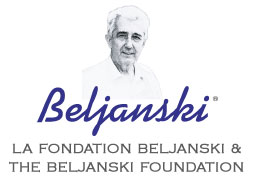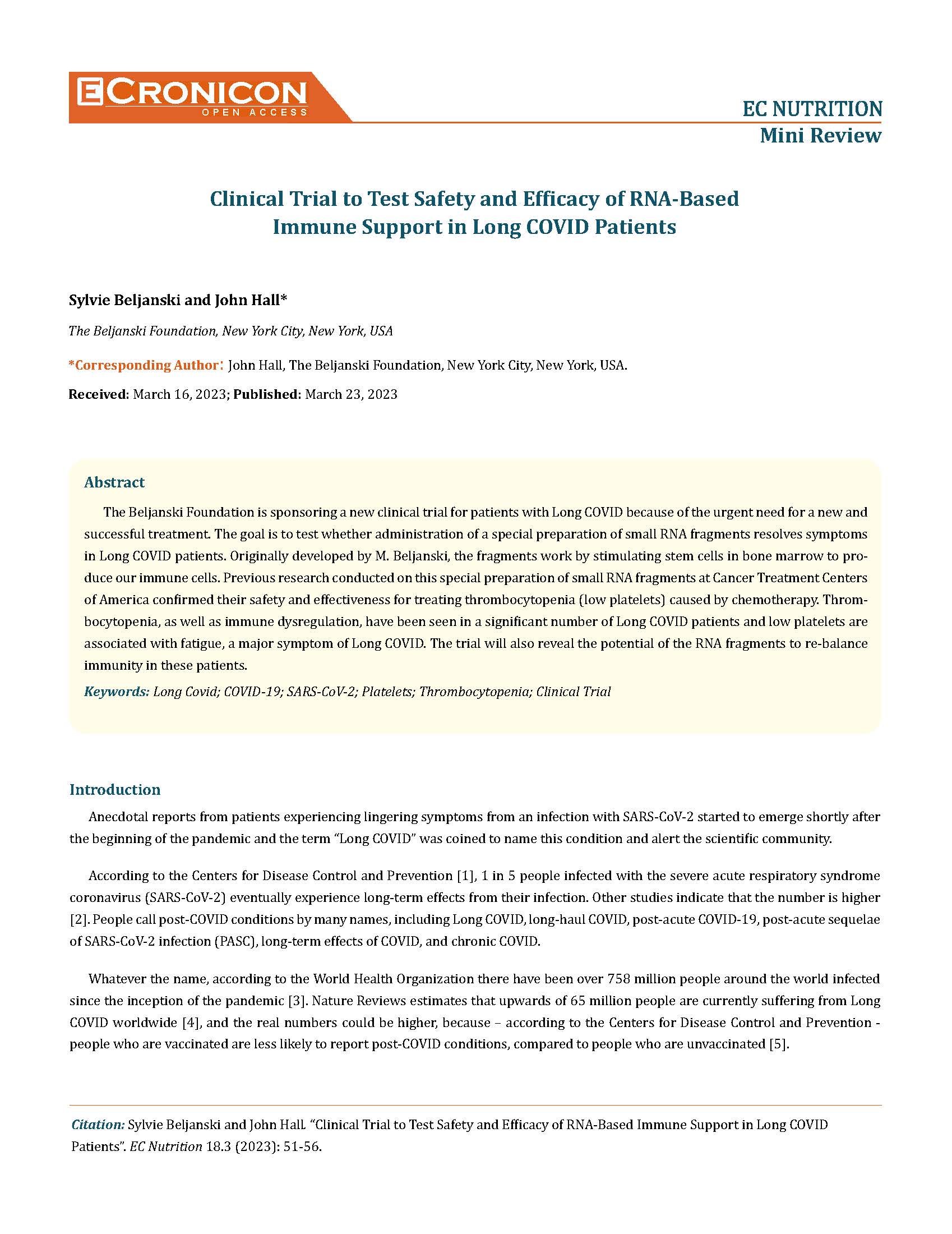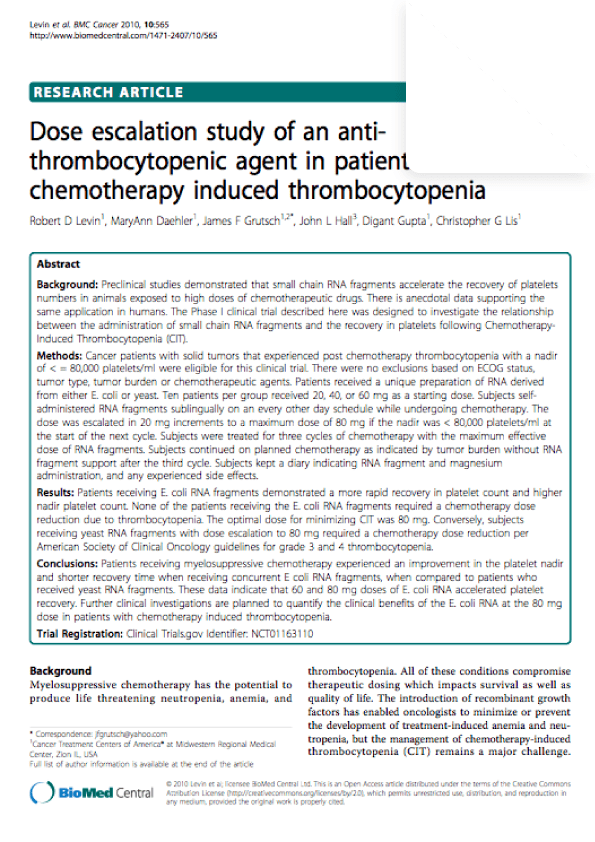Recherche sur les fragments ARN
La Fondation Beljanski finance un nouvel essai clinique pour les patients souffrant de COVID Long, car il est urgent de trouver de un traitement efficace. Des rapports anecdotiques de patients présentant des symptômes persistants d’une infection au SRAS-CoV-2 ont commencé à émerger peu après le début de la pandémie. Le terme « COVID Long » a été inventé pour nommer cette condition et alerter la communauté scientifique. Plus de 65 millions de personnes dans le monde souffrent aujourd’hui de cette maladie. L’objectif est de vérifier si l’administration d’une préparation spécifique de petits fragments d’ARN, développée à l’origine par le Dr Mirko Beljanski, pourra stimuler les cellules souches de la moelle osseuse pour produire de nouvelles cellules immunitaires. Des recherches antérieures, menées à partir de cette préparation de fragments d’ARN au Cancer Treatment Centers of America, ont confirmé son innocuité et son efficacité pour traiter la thrombocytopénie (faible taux de plaquettes) causée par la chimiothérapie.
Une thrombocytopénie a été observée chez un nombre important de patients atteints de COVID Long, et on remarque qu’un faible taux de plaquettes est souvent associé à de la fatigue, qui est elle-même un symptôme majeur de COVID Long. L’essai révélera également le potentiel des fragments d’ARN à rééquilibrer l’immunité chez ces patients.
Alors que le rôle des amorces d’ARN a été découvert pour la première fois par Okazaki, l’activité de ces courts segments d’ARN comme amorces pour initier la synthèse de nouveaux brins d’ADN a été identifiée à l’origine par le Dr Beljanski, alors qu’il travaillait à l’Institut Pasteur à Paris, en France. Les fragments agissent en stimulant les cellules souches dans la moelle osseuse pour produire nos cellules immunitaires. Ils sont disponibles comme complément alimentaire aux États-Unis depuis les années 90 : c’est cette préparation, commercialisée par la Maison Beljanski, qui sera utilisée pour l’essai clinique.
Les résultats de l’essai clinique devraient nous dire si l’activation des fonctions de la moelle osseuse et le renforcement de l’immunité du patient permettent de traiter efficacement le COVID Long.
« Les niveaux de plaquettes ont été mesurés chez les patients déprimés et se sont révélés faibles par comparaison aux témoins normaux. Par conséquent, l’interférence dans ce processus pourrait être une voie prometteuse pour d’autres recherches visant à traiter la thrombocytopénie légère chez les personnes atteintes de COVID Long, ainsi que les effets secondaires les plus courants de cette maladie, qui sont la fatigue et la dépression », explique le Dr John Hall, directeur de la recherche à la Fondation Beljanski.
Un faible nombre de plaquettes, une condition appelée thrombocytopénie, est un effet secondaire des médicaments chimiothérapeutiques qui endommagent les cellules souches de la moelle osseuse qui produisent normalement des plaquettes. Cet essai de phase I a montré que les fragments d’ARN de Beljanski pouvaient prévenir la thrombocytopénie en induisant la production de nouvelles plaquettes. Les patients prenant les fragments d’ARN ont eu leurs taux de plaquettes revenir à la normale et les traitements de chimiothérapie ont été terminés sans réduction de dose, transfusion de plaquettes ou suspensions. Les fragments d’ARN protégeaient les taux plaquettaires des patients atteints de nombreux types de cancer qui prenaient des médicaments anticancéreux différents en grand nombre. De plus, ces patients n’ont pas subi d’effets secondaires négatifs à la suite de la prise des fragments d’ARN contrairement aux malades n’en ayant pas reçu.
Les publications de Mirko Beljanski
Pendant qu’il développait ses extraits, le Dr Mirko Beljanski a nommé le Pao pereira: PB100, le Rauwolfia vomitoria: BG-8, le Gingko Biloba: Bioparyl et les fragments d’ARN: RLB
79 / BELJANSKI, M. PLAWECKI, P. BOURGAREL, M. S. BELJANSKI, “Nouvelles substances (R.L.B.) actives dans la leucopoïese et la formation des plaquettes“. Bull. Acad. Nat. Med., 1978, 162, Volume n°6, pp. 475-781.
83 / BELJANSKI, M. PLAWECKI, “Particular RNA Fragments as Promoters of Leukocytes and Platelets Formations in Rabbits“. Exp. Cell Biol., 1979, 47, pp. 218-225.
86 / BELJANSKI, “Oligoribo-nucleotides, promoters of leucocyte and platelet genesis in animals depleted by anticancer drugs”. NCI-EORTC Symposium on nature, prevention and treatment of clinical toxicity of anticancer agents. Institut Bordet, Bruxelles, 1980.
87 / BELJANSKI, M. PLAWECKI, P. BOURGAREL, M.S. BELJANSKI, “Short chain RNA fragments as promoters of leucocyte and platelet genesis in animals depleted by anti-cancer drugs”. In the Role of RNA in Development and Reproduction. Sec. Int. Symposium, april 25-30, 1980, pp.79-113. Science Press Beijing. M.C. Niu and H.H. Chuang Eds Van Nostrand Reinhold Company.
118 / DONADIO, R. LORHO, J.E. CAUSSE, T. NAWROCKI, M. BELJANSKI,” RNA Fragments (RLB) and Tolerance of CytostaticTreatments in Hematology:A Preliminary Study about Two Non-Hodgkin Malignant Lymphoma Cases“. Deutsche Zeitschrift für Onkologie, 23, 2, 1991, pp. 33-35.
119 / BELJANSKI, ” Reverse Transcriptases in Bacteria: Small RNAs as Genetic Vectors and Biological Modulators “. Brazil. J. Genetics, 14, 4, 1991, pp. 873-896.
120 / BELJANSKI, “Radioprotection of Irradiated Mice – Mechanisms and Synergistic Action of WR-2721 and R.L.B.”. Deutsche Zeitschrift für Onkologie, 23, 6, 1991, pp. 155-159.
121 / BELJANSKI, ” Overview: BLRs as Inducers of In Vivo Leucocyte and Platelet Genesis “. Deutsche Zeitschrift für Onkologie, 24, 2, 1992, pp. 41-46.
uncode-placeholder
Share





